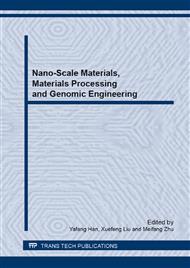p.391
p.396
p.403
p.409
p.415
p.419
p.424
p.431
p.436
Magnetic Properties of Cyano-Bridged Compound Co [Fe(CN)5NO]·5H2O
Abstract:
The cyano-bridged complex Co [Fe (CN)5NO]·5H2O has been synthesized. According to the reaction of cyanide-based unsaturated ligand precursor (molecular fragments)[BLy(CN)x]n-with the metal ions or complex unsaturated ligand, it is easy to control the structure of molecular magnets and tune up the magnetic properties. Hetero binuclear complex Co [Fe (CN)5NO]∙5H2O was prepared through [Fe (CN)5NO]2- ion. The room temperature Mossbauer spectrum revealed a doublet with the isomer shift parameter (-0.44(7) mm/s) and quadrupole splitting (QS = 1.91(3) mm / s) characteristic for low-spin Fe (III) ions. The low-spin (S = 1/2) of the Fe (III) ion of valence electrons on the electric field gradient (EFG) was caused by non-zero contribution. DC and AC magnetic measurements showed that the complexes belonged to the anti-ferromagnetic material, with a magnetic phase transition temperature below 2K.
Info:
Periodical:
Pages:
415-418
Citation:
Online since:
April 2014
Authors:
Price:
Сopyright:
© 2014 Trans Tech Publications Ltd. All Rights Reserved
Share:
Citation:


